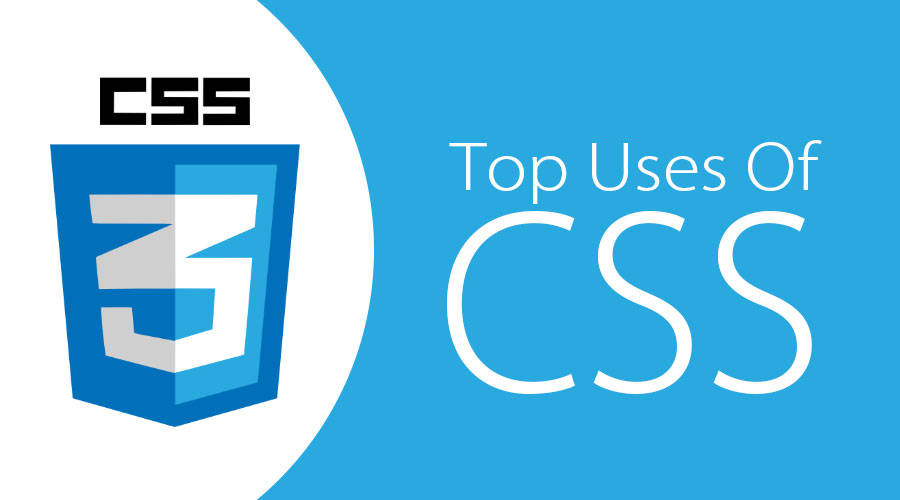Updated June 15, 2023
Introduction to Uses of CSS
CSS is the style sheet language for describing web page presentation and design, including colors, fonts, and layouts. Its main design objective is to enable the distinction between presentation and content, encompassing elements such as colors, layouts, and fonts. It offers compatibility with various devices, including large or small screens and printers. CSS operates independently of HTML and can be utilized with any XML-based markup language. The World Wide Web Consortium mainly maintains the CSS specifications. CSS rule set consists of a selector and a declaration block.
Some of the rules are described below:
Example:
h1 { color: white; font-style: italic }Here,
- Selector: h1 (It indicates the HTML element which needs to be styled)
- Property: “color and font-style” (It defines the aspects of elements that need to be changed)
- Declaration Block: “color: white; font-style: italic” (It describes one or more declarations separated by semicolons)
- Values: “white and italic” (It indicates the parameters of the selected properties.
Top Uses of CSS
Below are the top 10 uses are as follows:
1. Compatibility
While using CSS, a user can be stress-free with its older language versions as it is well-compatible even with the older versions. Due to this characteristic, even if CSS applications were developed using older versions of programming languages, they can still be easily incorporated and implemented with new enhancements. Developers can integrate CSS seamlessly with these changes, allowing them to update existing code without removing or discarding the changes associated with the predecessor of CSS.
2. E-Commerce Domain
CSS has played an important role in the E-Commerce domain. In the E-commerce domain, CSS plays a crucial role in styling and enhancing the visual appearance of application frameworks used across various industries, from small to large scale. CSS styling allows direct association with e-commerce websites and enables modification and updates to multiple add-ins and library files using CSS libraries, facilitating the creation of web applications. Developers can utilize the source code to build an e-commerce web platform from scratch by implementing CSS within the HTML framework.
3. Website Maintenance
Another common reason is why the uses of CSS are essential. CSS is essential for website upkeep. It makes website upkeep much easier. The CSS file determines how the website looks and feel more versatile and allows for more convenient customization. Also, it makes the HTML formatting and the corresponding data elements modification easier. Because of this, website maintenance becomes more convenient from the development perspective.
4. Social Media Impact
CSS in HTML frameworks is also being used in the construction of social networking websites. Facebook applications can be linked to the corresponding frameworks. Developers can implement HTML client library files based on CSS stylings to develop applications and work with various extensions. These frameworks can be interconnected with social media platforms to enhance the end-user experience. Thus, the CSS styling and updating the user interphase becomes easier, which directly impacts social media platforms.
5. Web-based Online Community and UI Approach
Based on the current standard, CSS can be implemented in different ways to develop any web-based application or any online community. There are different style sheet frameworks in CSS that can be implemented easily over here. Using CSS, the styling of the own online community can be developed. Developers can incorporate different add-ins using CSS frameworks to enhance the look and feel of web-based communities.
6. Easy Accessibility
From the accessibility point of view, applications of CSS provide much better solutions that allow users to update the user interphase to suit the business requirements. It also enables web pages to render easily on devices like speaking browsers, PDAs, and other devices. This actually provides a much deeper impact while considering the look and feel modification of a web page from the end-user and business perspective.
7. Image File Handling
In the case of image handling, the use of CSS provides the styling Library, which helps to output images along with the XML to the browser. Initially, updating and styling the existing image was a bit difficult. With CSS files, receiving output images in various formats such as JPEG, PNG, and GIF is now possible. Users can modify and style these images according to their specific requirements. This feature enables editing of different image types and facilitates tasks like creating thumbnails, applying watermarks, cropping images, and more.
8. Handling Dynamic Website Templates
Developers can create and handle dynamic website templates using CSS within the HTML framework. This enables seamless addition and editing of web pages and elements to web servers and sites. Adding CSS extension to the concerned HTML pages and incorporating the same with the server-side templates makes it easier to handle the dynamically allocated elements. So, using these templates, handling dynamic features can be more organized and adequately implemented by CSS frameworks. These elements can also style the pages in an active pattern while using the CSS templates.
9. Handling Flash Animation and Effects
CSS Flash files allow direct placement and handling of flash elements on websites. CSS includes built-in frameworks and style sheets that developers can utilize to manage such situations. The frameworks enable the creation of animations and updating of effects directly. Developers can use the properties to process and implement the necessary Flash files to incorporate movies and animations on web pages.
10. End-User and Server-side Representation
CSS files can directly interact with the user-end server-side response and serve for web server-side interface styling purposes. This allows for producing better web representation from the end user’s perspective.
Conclusion
After considering all the uses of CSS, we can conclude that CSS proves advantageous in representing and styling web application interfaces across different domains. Therefore, based on project needs and business requirements, implementing CSS can help achieve the desired goals.
Recommended Articles
We hope that this EDUCBA information on “Uses Of CSS” was beneficial to you. You can view EDUCBA’s recommended articles for more information.




